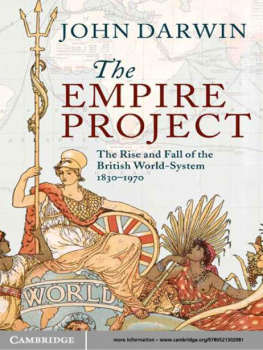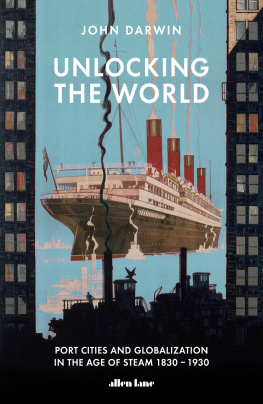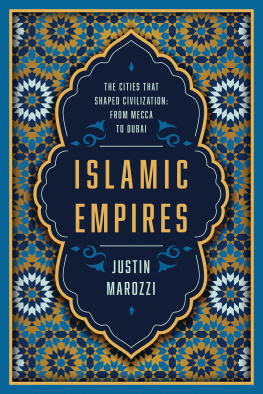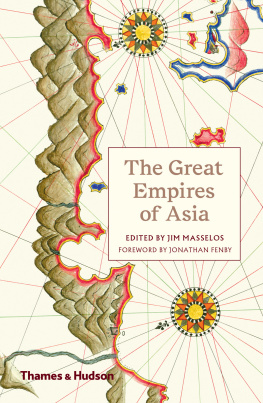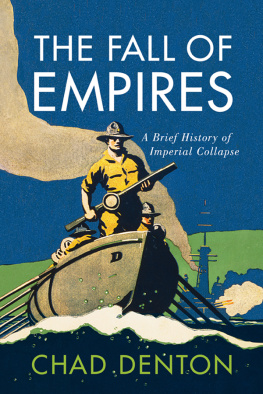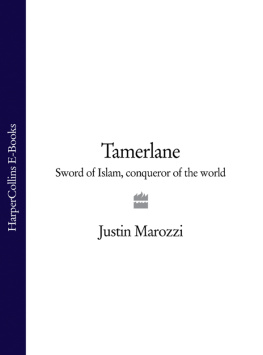After Tamerlane
BY THE SAME AUTHOR
Britain, Egypt and the Middle East:
Imperial Policy in the Aftermath of War 19181922
Britain and Decolonization:
The Retreat from Empire in the Post-War World
The End of the British Empire:
The Historical Debate
JOHN DARWIN
After Tamerlane
The Global History of Empire since 1405
ALLEN LANE
an imprint of
PENGUIN BOOKS
ALLEN LANE
Published by the Penguin Group
Penguin Books Ltd, 80 Strand, London WC2R 0RL, England
Penguin Group (USA) Inc., 375 Hudson Street, New York, New York 10014, USA
Penguin Group (Canada), 90 Eglinton Avenue East, Suite 700, Toronto, Ontario, Canada M4P 2Y3
(a division of Pearson Penguin Canada Inc.)
Penguin Ireland, 25 St Stephens Green, Dublin 2, Ireland
(a division of Penguin Books Ltd)
Penguin Group (Australia), 250 Camberwell Road, Camberwell, Victoria 3124, Australia
(a division of Pearson Australia Group Pty Ltd)
Penguin Books India Pvt Ltd, 11 Community Centre, Panchsheel Park, New Delhi 110 017, India
Penguin Group (NZ), 67 Apollo Drive, Rosedale, North Shore 0632, New Zealand
(a division of Pearson New Zealand Ltd)
Penguin Books (South Africa) (Pty) Ltd, 24 Sturdee Avenue, Rosebank, Johannesburg 2196, South Africa
Penguin Books Ltd, Registered Offices: 80 Strand, London WC2R 0RL, England
www.penguin.com
First published 2007
1
Copyright John Darwin, 2007
The moral right of the author has been asserted
All rights reserved.
Without limiting the rights under copyright
reserved above, no part of this publication may be
reproduced, stored in or introduced into a retrieval system,
or transmitted, in any form or by any means (electronic, mechanical,
photocopying, recording or otherwise) without the prior
written permission of both the copyright owner and
the above publisher of this book
A CIP catalogue record for this book is available from the British Library
EISBN: 9780141904689
For Caroline, Claire, Charlotte and Helen
Contents
List of Illustrations
Photographic acknowledgements are given in parentheses.
List of Maps
Preface
The death of Tamerlane in 1405 was a turning point in world history. Tamerlane was the last of the series of world-conquerors in the tradition of Attila and Genghis Khan, who strove to bring the whole of Eurasia the world island under the rule of a single vast empire. Within fifty years of his death, the maritime states of the Eurasian Far West, with Portugal in the van, were exploring the sea routes that became the nerves and arteries of great maritime empires. This is the story of what happened next.
It seems a familiar tale, until we look closer. The rise of the West to global supremacy by the path of empire and economic pre-eminence is one of the keystones of our historical knowledge. It helps us to order our view of the past. In many standard accounts, it appears all but inevitable. It was the high road of history: all the alternatives were byroads or dead ends. When Europes empires dissolved, they were replaced by new post-colonial states, just as Europe itself became a part of the West a world-spanning league under American leadership. The aim of this book is partly to show that the passage from Tamerlanes times to our own has been far more contested, confused and chance-ridden than this legend suggests an obvious enough point. But it tries to do this by placing Europe (and the West) in a much larger context: amid the empire-, state- and culture-building projects of other parts of Eurasia. Only thus, it is argued, can the course, nature, scale and limits of Europes expansion be properly grasped, and the jumbled origins of our contemporary world become a little bit clearer.
This book could not have been written without the huge volume of new writing in the last twenty years both on global history and on the histories of the Middle East, India, South East Asia, China and Japan. Of course, it is not only recently that historians have insisted on a global view of the past: that tradition, after all, goes back to Herodotus. Hidden in most histories lies a set of conjectures about what was supposed to have happened in other parts of the world. Systematic inquiry into the linkages between different parts of the world is, however, comparatively recent. The study of the past, remarked Frederick Teggart in his Rome and China (Berkeley, 1939), can become effective only when it is fully realized that all peoples have histories, that these histories run concurrently and in the same world, and that the act of comparing them is the beginning of knowledge.1 This challenge was taken up on a monumental scale in W. H. McNeills The Rise of the West (Chicago, 1964), whose title belies its astonishing range and intellectual subtlety. But in recent years the resources committed to global and non-Western history have increased enormously. The economic, political and cultural impact of globalization has been one of the reasons. But perhaps just as important have been the effects of diasporas and migrations (creating a mobile, anti-national historical tradition) and the partial liberalization of many regimes (the greatest example being China) where history was once treated as the private property of the state. New perspectives, new freedoms and new reading publics, wanting new meanings from history, have fuelled a vast outpouring of historical writing. The effect of all this has been to open new vistas on a past that once seemed accessible by only one route the story of Europes expansion. It has made it much easier than a generation ago to see that Europes trajectory into the modern world shared many features in common with social and cultural changes elsewhere in Eurasia, and that Europes attainment of primacy came later, and was more qualified, than we are often led to believe.
My debts to the work of other historians will be obvious from the notes that accompany each chapter. My first introduction to the fascination of viewing world history as a connected whole came as a pupil of the late Jack Gallagher, whose historical imagination was boundless. I have learned an enormous amount from my colleagues in imperial and global history in Oxford Judith Brown, David Washbrook, Georg Deutsch and Peter Carey and have benefited from the expert knowledge of many other colleagues in the university and beyond, whose words of wisdom I have tried to remember. My thinking about the economic issues has been much improved by acquaintance with the Global Economic History Network, created by Patrick OBrien as a forum for discussing the divergent paths of economic change in different parts of the world. Some of the ideas to be found in this book were prompted by arguments with James Belich and Phillip Buckner in several travelling seminars. The stimulus of teaching so many talented students has been indispensable, and my historical education has been hugely extended by the supervision of many doctoral theses over the last twenty years. I am especially grateful to those friends and colleagues who commented on earlier versions of the chapters that follow: Richard Bonney, Ian Phimister, Robert Holland, Martin Ceadel and Andrew Hurrell. The errors and omissions I claim for myself.
I prepared draft maps using as a base the Mapinfo program produced by Collins Bartholomew. I could not have done so without the instruction, advice and patient assistance of Nigel James of the Bodleian map department: it is a pleasure to acknowledge his help. The finished maps were drawn by Jeff Edwards. I am greatly indebted to Bob Davenport for his meticulous care in the copy-editing of the text.


